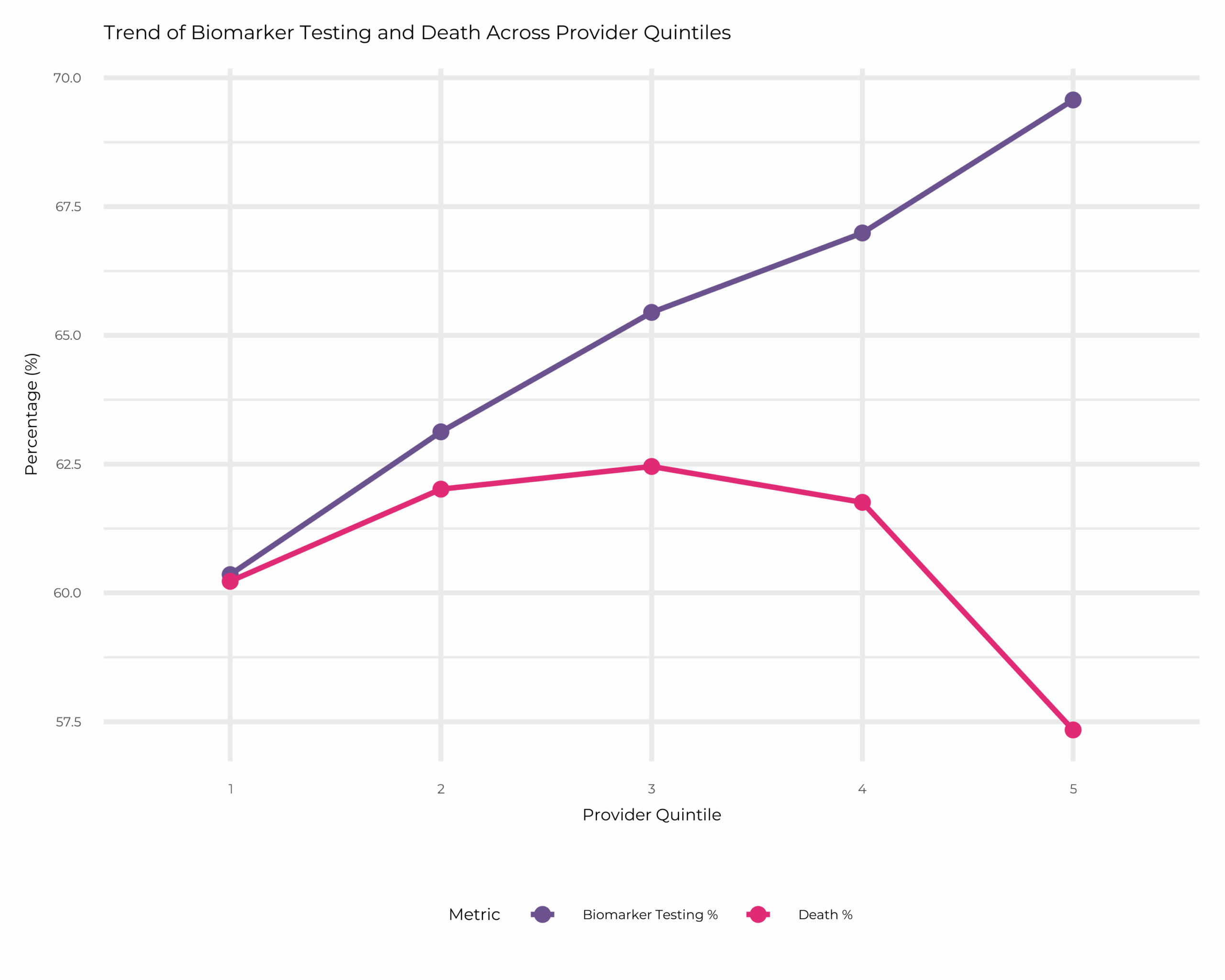Biomarker testing guides selection of targeted therapies in non–small cell lung cancer (NSCLC). Despite its clinical importance, the extent of provider variation in biomarker testing practices and its correlation with patient outcomes has not been thoroughly explored.
This research was conducted by Grace K. Kane, MS; Diane Faraone, PharmD; Douglas Londono, PhD; Nathan J. Markward, PhD, MPH
Objective:
This study aims to characterize trends in biomarker testing rates and associated crude mortality among a national cohort of patients with NSCLC, stratified by provider patient volume.
Design:
This was a retrospective cohort study using U.S. medical and pharmacy claims from the PurpleLab® Comprehensive Layout for Exploration Analysis & Research (CLEAR) database. Patient collection and cohort construction followed standard health economics and outcomes research (HEOR) practices, including claims-based identification, continuous enrollment requirements, and a pre-index washout.
The study period was January 2019 through June 2024. The index date was the first recorded diagnosis of metastatic NSCLC between January 2020 and June 2023. A 12-month washout period preceded each index to establish incident metastatic status. Indexing was stopped in June 2023 to ensure at least 12 months of potential follow-up for all patients. Patients were attributed to oncology providers using their National Provider Identifier (NPI), and providers were then stratified into quintiles based on the number of attributed patients.
Main Outcomes and Measures:
The primary outcome measure is the proportion of patients who received biomarker testing within each provider-volume quintile. This is defined as the number of unique patients with evidence of any biomarker test divided by the total number of unique patients in that quintile (i.e., patient-weighted within quintile).
The secondary measure is the crude mortality proportion within each provider-volume quintile. This is defined as the number of patients with a recorded death during the available follow-up period divided by the total number of unique patients in that quintile.
Results:
The analysis included 11,539 oncology providers and 75,524 NSCLC patients. The mean biomarker testing rate for providers in Quintile 1 (lowest patient volume) was 60.36%, compared to 69.57% for providers in Quintile 5 (highest patient volume). Patient mortality showed an inverse relationship with provider volume, decreasing from 60.23% in Quintile 1 to 57.34% in Quintile 5.
Statistical analysis using the Kruskal-Wallis test demonstrated a significant difference in biomarker testing rates across provider quintiles (p<0.0001). Post-hoc, pairwise, Dunn’s tests with Bonferroni correction confirmed significant differences between lower and higher quintiles. Notably, testing rates and mortality were relatively consistent across Quintiles 1 through 4 but showed a marked divergence in Quintile 5.
Discussion:
This study demonstrates a positive correlation between provider patient volume and biomarker testing rates, which is inversely associated with patient mortality (Figure 1). While this observational design precludes the inference of causality, the findings suggest that high-volume providers may be more integrated into clinical pathways for molecular testing and have greater access to, or expertise in, administering targeted therapies. This highlights a potential variation in the quality of care, as lower-volume providers may face systemic barriers to timely biomarker testing.

Future research will use Cox proportional hazards models to assess the influence of provider-level factors on patient survival. It will also incorporate adjustment for patient-level comorbidity burden using either Charlson or Elixhauser comorbidity indices.
Conclusion:
This analysis revealed a statistically significant positive association between provider patient volume and biomarker testing rates; higher volume was also linked with lower mortality. These findings support initiatives to standardize guideline-concordant biomarker testing across oncology settings, with a particular focus on low-volume providers. This standardization can help to reduce inter-provider variability in NSCLC care.
Why PurpleLab is your Trusted Partner in Real-World Data and Analytics:
Navigating real-world oncology care requires robust data insight. Analysis of PurpleLab’s CLEAR® database uncovered significant clinical variations in biomarker testing and mortality by provider volume. This heterogeneity may contribute to differences in patient access to targeted therapies and, ultimately, divergent outcomes. These findings highlight the need for standardized, guideline-concordant testing to ensure timely access to the right treatment for the right patient.
By leveraging these insights, the following groups can support greater alignment with guideline-concordant care:
- Market Access teams can use real-world evidence to quantify unmet clinical needs, inform value-based frameworks, and design effective strategies at the population level.
- Providers can benchmark their biomarker testing practices, identify care gaps, and better align with precision oncology standards.
- Patients gain greater transparency in testing patterns, which can help them make informed decisions and have discussions with their providers to ensure they receive appropriate molecular testing.
Looking forward, real-world analytics can help the healthcare industry move beyond simple observation toward actionable interventions. This can accelerate the adoption of biomarker-guided therapy and improve outcomes at the point of care, where it matters most.